Round The World and other travels
A frequent flyer's collection of trip diaries
This is: Bohemian Rhapsody (2014)
A day on the left bank
|
RIGHT: Approaching Tyn Church, which looked just as impressive in daylight. The Sunday morning sense of tranquility is clear. |
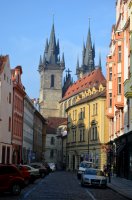 |
Sunday dawned bright and cold, the blue sky looking considerably more promising than the layer of grey cloud predicted in the previous day's weather forecast. We took the time to enjoy a nice breakfast at the Hilton but, conscious that we had planned an ambitious programme, didn't waste too much time before setting out.
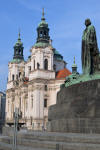 |
 |
 |
|
| ABOVE: Passing through Old Town Square and in front of the Rudolfinum | |
| BELOW: Crossing the Vltava to the Little Quarter | |
 |
|
Prague city centre is conveniently divided into four quarters: the Old Town and New Town on the right bank of the Vltava, and the Castle District and Little Quarter on the left bank. Based in the Old Town, we intended to reach the Castle District by walking through our own quarter as far as the river, then crossing over into the Little Quarter and heading uphill. (Had we not felt up to the walk, tram route 22 would have provided an alternative means of getting started.) A thorough exploration of both the castle complex itself and the rest of the Castle District formed the main objective, and if time permitted, we would attempt to see more of the Little Quarter before returning to base.
We tried to vary our initial route from that of the previous evening, but almost inevitably passed through Old Town Square again, marvelling at the sense of peace and calm brought by a Sunday morning. Continuing towards the river brought us to the Rudolfinum, a notably grand 19th-century building that today, following restoration in the 1990s, is home to both an art gallery and to the Czech Philharmonic Orchestra. A short walk across the Manesuv Bridge then led us onto the left bank and Prague's so-called Little Quarter.
This area, known as Malá Strana locally (or more formally as Menší Město pražské, the Lesser Town of Prague) is the second oldest of central Prague's four quarters, today mainly noted for its charming cobbled streets and Baroque architecture. Hoping to have time for a closer look later in the day, we pressed onwards and upwards towards our goal, first in the direction of the main square (Malostranské náměstí) and then towards probably the most arduous climb to the castle, the steep little side alley and daunting flight of steps leading off Nerudova Street. With the main objective now clearly within reach, however, we allowed ourselves the luxury of pausing for a few photos along the way, although these were made a little challenging by lingering wisps of early-morning haze that hadn't yet burned off.
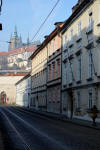 |
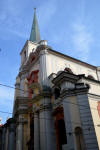 |
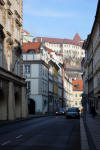 |
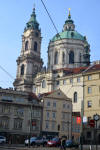 |
 |
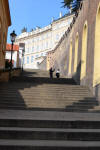 |
| ABOVE: A few images of the Little Quarter, eventually leading to those steps! | |||||
 The
stairs successfully negotiated, we found ourselves
in the Castle District (Hradčany), overlooking much of the
city of Prague. We took a few minutes to recover our composure but
didn't take photos at this stage owing to a combination of the
position of the sun and those pesky remnants of overnight mist.
Behind us on this hilltop location stood the castle complex itself
and the many other interesting buildings of the Hradčany
district. Gazing out across the city as it slowly came to life, our
attention was suddenly caught by something very much closer at hand:
what must surely qualify as the best-located branch of Starbucks in
Europe, if not the world! However incongruous it may sound, this was
an irresistible opportunity to reward the physical exertions so far
by sitting down with a nice latte, while also absorbing the fabulous
urban panorama.
The
stairs successfully negotiated, we found ourselves
in the Castle District (Hradčany), overlooking much of the
city of Prague. We took a few minutes to recover our composure but
didn't take photos at this stage owing to a combination of the
position of the sun and those pesky remnants of overnight mist.
Behind us on this hilltop location stood the castle complex itself
and the many other interesting buildings of the Hradčany
district. Gazing out across the city as it slowly came to life, our
attention was suddenly caught by something very much closer at hand:
what must surely qualify as the best-located branch of Starbucks in
Europe, if not the world! However incongruous it may sound, this was
an irresistible opportunity to reward the physical exertions so far
by sitting down with a nice latte, while also absorbing the fabulous
urban panorama.
Prague Castle
Duly re-invigorated, we were now ready to explore the first main highlight of the day, Prague Castle. Dating from AD 870, this former seat of the Kings of Bohemia is reputed to be the largest surviving ancient castle in the world. Like the Kremlin or the Alhambra, the complex is almost a small city in its own right, with its array of fortifications, palaces, churches and museums. Additionally, it is nowadays the official residence and working headquarters of the President of the Czech Republic. Specific attractions include St Vitus' Cathedral, a striking example of mainly Gothic architecture; the old Royal Palace; St George's Basilica, together with its former convent building; the Golden Lane, with its brightly-coloured little houses; Dalibor Tower, part of the castle's defences and a former prison; and the Rosenberg Palace, a former 'residence for unmarried noblewomen', apparently! We took the route favoured by many tourists, beginning at the western gate in the Castle District's main square, Hradčanské náměstí, and progressing eastwards through a succession of courtyards and lanes. Briefly emerging through the small eastern gate we then partly retraced our steps, making a point of diverting to see the defensive gorge and the Royal Garden on the north side.
 |
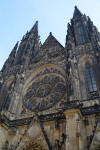 |
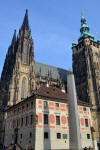 |
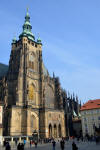 |
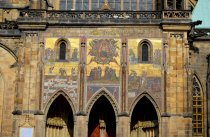 |
|
 |
|||||
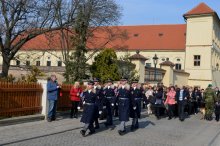 |
 |
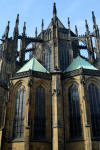 |
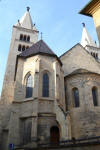 |
 |
|
 |
 |
||||
Finally, we managed to catch one of the highlights of any tourist's visit to the castle, the popular Changing of the Guard ceremony that takes place daily at 12 noon.
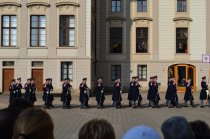 |
 |
LEFT: Changing of the Guard ceremony |
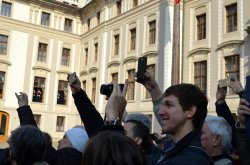 |
 |
RIGHT: Sign of the times - a host of electronic devices held aloft, only one of which is instantly recognisable as a camera |
Remainder of the Castle District
With the spectacle over and the crowd rapidly dissipating, we decided to make a start on seeing what lay outside the castle precincts, in the hope of finding a suitable lunch spot along the way. The main square itself was home to the beautiful Archbishop's Palace, while opposite that the Schwarzenberg Palace's walls were covered in clever 3D effects. As we veered off into some of the quieter side streets, the crowds simply melted away and it was in one of these little lanes that, quite by chance, we found an attractive restaurant called U Zlaté Hrušky, or 'The Golden Pear'. We both decided on lighter options, avoiding a main course altogether; we didn't want overly full stomachs sapping our energy levels for the afternoon. I had Czech onion soup followed by a plate of smoked tongue, both accompanied by plenty of fresh local bread.
 |
 |
 |
 |
 |
 |
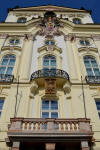 |
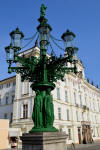 |
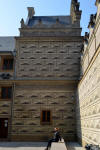 |
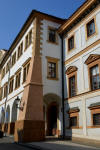 |
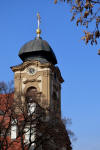 |
ABOVE: Lunch stop LEFT and ABOVE LEFT: Exploring the part of the Castle District that lies outside the castle precincts |
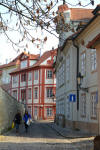 |
 |
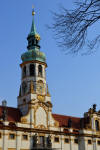 |
 |
||
| ABOVE: A quiet corner of the Castle District and the Loreta tower | ||
After that, we continued through the network of small side streets to re-emerge into the square that sits between the Loreta and the Czernin Palace, both significant buildings in the Baroque style. The former is a Catholic shrine and place of pilgrimage, built in the 17th century around the legend of the Santa Casa in an attempt to rally people behind the Counter Reformation movement. The building is also well known today for its impressive treasury and its 30-bell, Dutch-built carillon. Meanwhile, the Czernin Palace across the square has a more down-to-earth role as home to the Czech foreign ministry.
Strahov Monastery
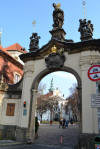 |
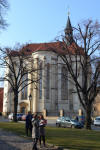 |
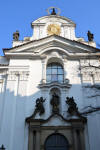 |
 |
 |
It was but a short walk from there to the Strahov Monastery which, in relation to the castle itself, represents the opposite extremity of the Castle District. Dating from 1140, the monastery is noted for its Baroque church and for its impressive library, spread over the so-called Theological Hall and Philosophical Hall. We strolled through the grounds and had a brief look inside as well.
Little Quarter revisited
Exiting the monastery by its eastern gate, we immediately began the descent back to the Little Quarter on paths of varying quality through the open parkland. Perhaps not surprisingly on what had become a glorious spring afternoon, the place was teeming with local people out for a stroll after Sunday lunch. Emerging near the German Embassy on Vlašská Street, we enjoyed strolling through the colourful and quiet little streets of this part of the Little Quarter, stopping along the way at a tiny local coffee shop for some afternoon refreshment.
We completed our second pass of the day through this part of Prague by heading first for its main square and then for the Charles Bridge, that unforgettable vantage point from the previous evening. The centuries-old, statue-bedecked, sandstone bridge also happens to be one of the best-known sights in the city in its own right. It was certainly busy with sightseers, peddlers of tourist knick-knacks and caricature artists as we crossed back to the right bank on what for centuries was the only available route. The river looked particularly placid in the late afternoon sunshine, which seemed a trifle ironic given that the name Vltava is believed to mean 'wild water'. (Pronounce 'wild' the German way and you're already halfway there; then it's a matter of accepting that 'ava' is derived from the Latin word aqua.)
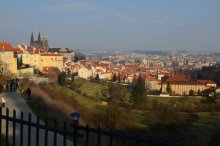 |
 |
 |
 |
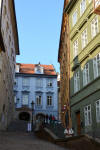 |
|
 |
 |
 |
|||
 |
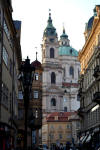 |
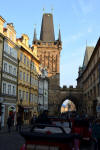 |
 |
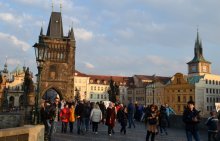 |
|
 |
 |
||||
And back to the Old Town
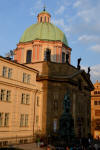 |
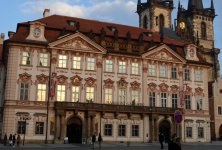 |
As we passed through Old Town Square one more time on our way back to the hotel, the red glow of the setting sun meant that we were again seeing it, quite literally, in another light.
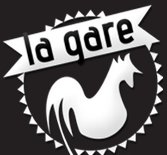 After
a short interlude to rest our weary feet, we once again availed
ourselves of the 'happy hour' offerings in the executive lounge
before setting off on a very short walk to dinner. The chosen venue
was the French brasserie La Gare, a close neighbour of the
Hilton Old Town, where I enjoyed fish soup and a rabbit main course.
After
a short interlude to rest our weary feet, we once again availed
ourselves of the 'happy hour' offerings in the executive lounge
before setting off on a very short walk to dinner. The chosen venue
was the French brasserie La Gare, a close neighbour of the
Hilton Old Town, where I enjoyed fish soup and a rabbit main course.
It had been a hugely successful day's sightseeing in glorious spring sunshine in one of the most beautiful cities in Europe. A good night's rest was now essential, as the following day's planned programme was only marginally less ambitious.